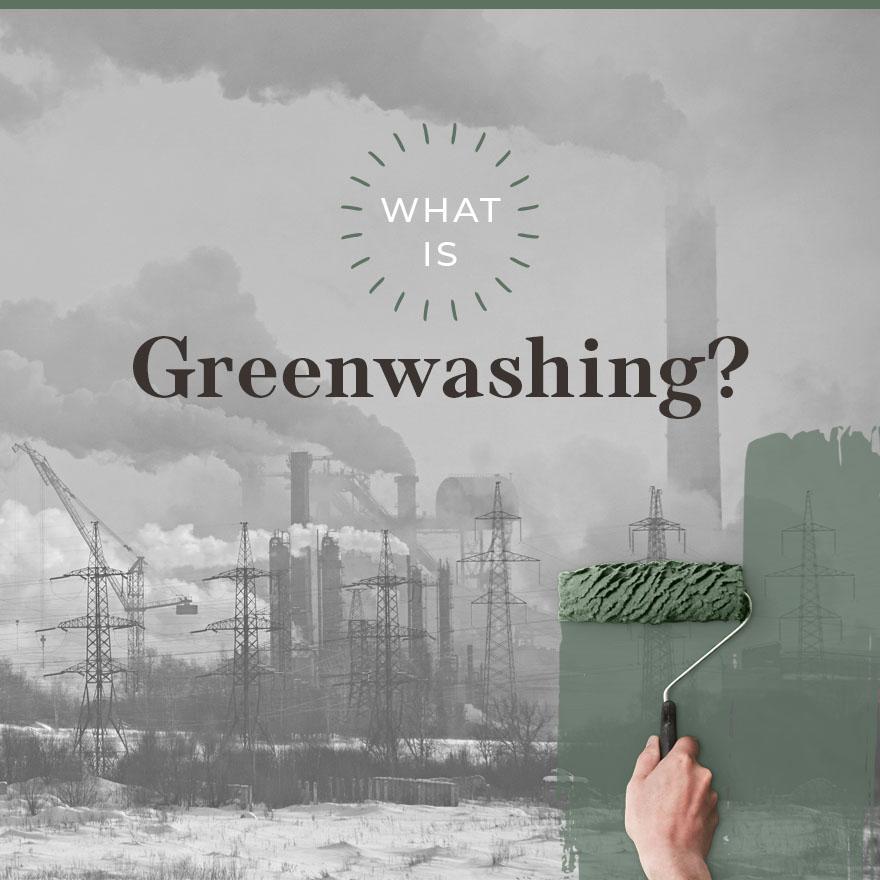
While many people have been championing sustainable lifestyles for a very long time, there’s no denying that sustainability is increasingly “on trend” at the moment. According to the World Economic Forum, online searches for sustainable goods have risen by 71 percent over the past five years, signaling a strong shift towards “conscious consumerism.” As a result, some companies have launched sustainable alternatives to our favorite household products, from plastic-free shampoo bars to bamboo toothbrushes.
It’s great to have more sustainable choices in our everyday lives. But with so many brands creating eco-friendly products and collections, it’s getting harder and harder to tell the difference between companies that are actually eco-friendly and ones that exaggerate their environmental credentials (aka, “greenwashing”) to grow their bottom line.
No one likes to be duped, especially by large corporations whose activities have an outsized impact in driving climate change. In this guide, we’ll explain what greenwashing is and how to identify it so you can make better decisions for yourself and the environment.
Learn More About The Earthling Co.
What Is Greenwashing?
In a nutshell, greenwashing describes the practice of giving consumers the false impression that a company’s products or services are more environmentally friendly than they actually are.
The term was first used in 1986 by activist Jay Westerveld, who noted the hypocrisy of a luxury hotel asking guests to reuse their towels to conserve water, even as they wasted resources in other ways. Nowadays, it’s often used to describe companies that mislead consumers into acting unsustainably, often through deceitful marketing tactics.
For example, a company might try to put their plastic products in a better light by saying they’re made from “100% recyclable PET plastic.” But this conveniently ignores the fact that the vast majority of plastic isn’t recycled and is destined for a landfill one way or another.
Why Do Companies Greenwash?
It’s simple — sustainability sells. According to a recent study from Greenprint, an environmental tech company, the vast majority of Americans are interested in making better choices for the planet, with 78 percent of Americans saying that they were more likely to buy a product with eco-friendly labels.
Businesses and organizations are hyper-aware of this, too. Hence, many of them are now trying to appeal to eco-conscious consumers while making few (if any) real sustainable changes to their business practices.

The Problem with Greenwashing
Companies using questionable tactics to sell more products is nothing new. But the problem with greenwashing goes beyond companies getting undeserved credit for their perceived eco-friendliness.
- Greenwashing Harms the Planet – The main issue with greenwashing is that it tricks well-intentioned people into believing they’re acting sustainably. If a company touts their product as being eco-friendly, you may be more likely to buy that product. But if the product turns out to be harmful to the environment, then you’re accidentally contributing to the problem.
- Greenwashing Makes People Complacent – People often accept greenwashing claims without fact-checking them. Why? Because it’s easier to believe that a company is taking care of the problem rather than calling out greenwashing and finding a different product or service. Greenwashing can lull us into a sense of complacency at a time when we should be making waves in environmental activism.
- Greenwashing Reduces Corporate Accountability – Another problem with greenwashing is that it makes people believe that large corporations are their partners in the fight against climate change as opposed to key contributors to the problem. The fact of the matter is, the largest corporations are responsible for more than 70 percent of global emissions. When we accept a company’s “green lies,” it takes the pressure off them, making it easier to evade legislation that would hold them accountable.
Common Types of Greenwashing (Plus Examples)
Everyone expects greenwashing to be obvious, but that’s not always the case. In fact, greenwashing is usually subtle and difficult to recognize — especially when you really want to believe that a company and its products are good for the environment.
To give you a better idea of how greenwashing works, here are some common types of greenwashing that companies frequently use to mislead consumers.
1. “Green” Imagery
The next time you’re tempted to buy a product that appears eco-friendly, read the fine print before you add it to your cart. Many companies use “green” imagery on packaging — waterfalls, leaves, cute animals, etc. — to imply that their product is good for the environment.
Packaging with a green color scheme is another red flag. Although many legitimate, sustainable brands use a green color scheme, this color has recently been hijacked by many companies who have no interest in helping the environment.
Example:
One of the largest diaper brands carries a “Pure & Natural” line that depicts a nearly-naked baby surrounded by leaves or grass, implying that the product is good for the baby’s skin and the environment. This ignores the fact that disposable diapers take up a huge amount of space in landfills. What’s more, only a small portion of the diaper is organic cotton and it doesn’t even touch the baby’s skin since it’s located on the outside of the diaper.

2. Irrelevant Claims
Most of us have been fooled by this type of greenwashing before. Greenwashing irrelevancy is when a company technically tells the truth about their product, but the claim is either unhelpful or irrelevant to consumers who are seeking an eco-friendly option.
Example:
Products that claim to be “chemical-free.” Chemicals aren’t inherently bad. In fact, everything is made of chemicals, including water!
Another example of this type of greenwashing is when companies claim that their baby bottles are “BPA-free.” Baby bottles must be BPA-free by law, making this claim unremarkable and irrelevant to the consumer.
3. Vague Language
This type of greenwashing is when brands use vague terminology to describe their products. For instance, a company that claims to be conscious of the environment might use “green” terminology such as “all-natural” and “eco-friendly” because these words have no clear meaning and can easily mislead consumers.
Eco-friendly is an especially murky term because there are many different factors that go into a product being environmentally friendly. The next time you see a product claiming to be eco-friendly, try to find the “how.” How is this product eco-friendly, exactly? If you can’t find the answer, reach out to the company and ask.

Example:
Single-use face wipes with a “biodegradable” label are an example of vague terminology that may be a sign of greenwashing. Biodegradable is an unregulated term that doesn’t indicate when a product will break down. Biodegradable face wipes could take 1,000 years to break down and, technically, the company would still be telling the truth. Instead, you could look for reusable products made from natural materials such as reusable cotton rounds, which can be used indefinitely and decompose into natural materials within a specific time frame.
4. Untruthful Advertising
Sometimes “green” lies in advertising are easy to spot. For example, a shampoo bottle might claim that it’s “made from recyclable materials,” followed by an asterisk that directs readers to the back of the bottle where it says that only 20 percent of the bottle is made from recyclable plastic. (All the more reason to ditch plastic altogether and switch to plastic-free shampoo and conditioner bars.)
See How The Earthling Co. Gives Back
Other untrue claims are trickier to disprove and may require the consumer to do some digging. In cases like these, brands are usually banking on the fact that most consumers are too busy to do their research and uncover the actual truth.
5. Red Herrings
Fossil fuel companies have become notorious for this greenwashing tactic, which involves promoting a token act of sustainability to draw attention away from a company’s otherwise environmentally harmful business practices. But in reality, these same companies often spend hundreds of millions of dollars lobbying to block or delay climate-motivated policies.
Example:
In 2017, an oil and gas company launched a string of campaigns promoting algae as a potential source of biofuels. The ads touted that the company could be producing as much as 10,000 barrels of biofuel a day, giving consumers the impression that the company was making a serious effort to reduce its environmental impact. But according to an analysis published by environmental lawyers ClientEarth, the oil giant had no company-wide net zero emissions target at the time and only spent 0.2 percent of its capital expenditure on sources of low-carbon energy.

How to Avoid Greenwashing
- Take the time to research the company and their founders. Check out their website and be sure to go beyond the homepage. Read their About Me page to learn more about the purpose and mission of the company. Do some more digging on their products by checking out their FAQ page.
- Inspect the packaging. A company’s product packaging can be very telling. For example, many low waste products feature images of nature, but the product packaging itself could be made from unrecyclable materials that contribute to our growing waste problem.
- Look for third-party certifications. Third-party certifications from established organizations such as 1% for the Planet, Climate Neutral, Green Seal, B Corp, Carbon Trust and GOTS (Global Organic Textile Standard) are a good indication that a company is making a genuine commitment to the environment. However, keep in mind that obtaining third-party certifications usually requires time and money — two things which smaller brands often lack. In other words, don’t rule out a truly amazing company just because they aren’t certified. (The Earthling Co. is Climate Neutral Certified, and we are a member of 1% for the Planet!)
- Beware of buzzwords. This goes back to the vague language mentioned earlier. When a product is labeled as “natural” or “organic,” look at the ingredients, do your research, and decide for yourself.
- Consider the bigger picture. There are plenty of products out there that are sustainable in one way, but harmful in others. For example, fast-fashion companies may use recyclable materials, but their products are still mass-produced in factories that use fossil fuels, and their marketing efforts promote overconsumption. When shopping for eco-friendly products, consider the product’s entire lifecycle. Where was the product made? How were the raw materials extracted? What happens to the product at the end of its life?
What to Do When You See It
When you encounter greenwashing, it might be tempting to go to the offending brand’s social media and put them on blast for all to see. But this approach can make some companies defensive and less likely to pursue sustainable efforts in the future. Plus, we’re all learning.
Instead of publicly calling them out, consider sending the company a private message first. Explain why their efforts are greenwashing, why it’s problematic, and frame the issue as a way to find a better solution. Sometimes, businesses are trying to do better, but don’t know how to go about it.

If the company doesn’t have a good response or ignores you altogether, take to social media and call them out. Leaving constructive comments on a brand’s social media page is good for helping other consumers avoid falling victim to greenwashing.
Another option is to take your complaints to the Federal Trade Commission (FTC), which is a government agency designed to protect consumers. If a company makes a false claim about their products or services, report it to the FTC.
The Takeaway
We all want to do our part for the planet, and one way to do that is by supporting businesses that leave as little impact on the environment as possible. Collectively, our wallets have a lot of power. By staying greenwashing vigilant, we can spend our dollars more wisely and influence companies to make real changes.
Looking for more helpful tips and tricks to lower your environmental impact? Check out How to Use Less Plastic and more articles from The Earthling Co. blog!
Image Credits
Orfeev/Shutterstock.com
artnLera/Shutterstock.com
aapsky/Shutterstock.com
artic_photo/Shutterstock.com
Oliver Hoffmann/Shutterstock.com
Yeti studio/Shutterstock.com
Narith Thongphasuk38/Shutterstock.com
Prostock-studio/Shutterstock.com
stock-enjoy/Shutterstock.com
fizkes/Shutterstock.com





